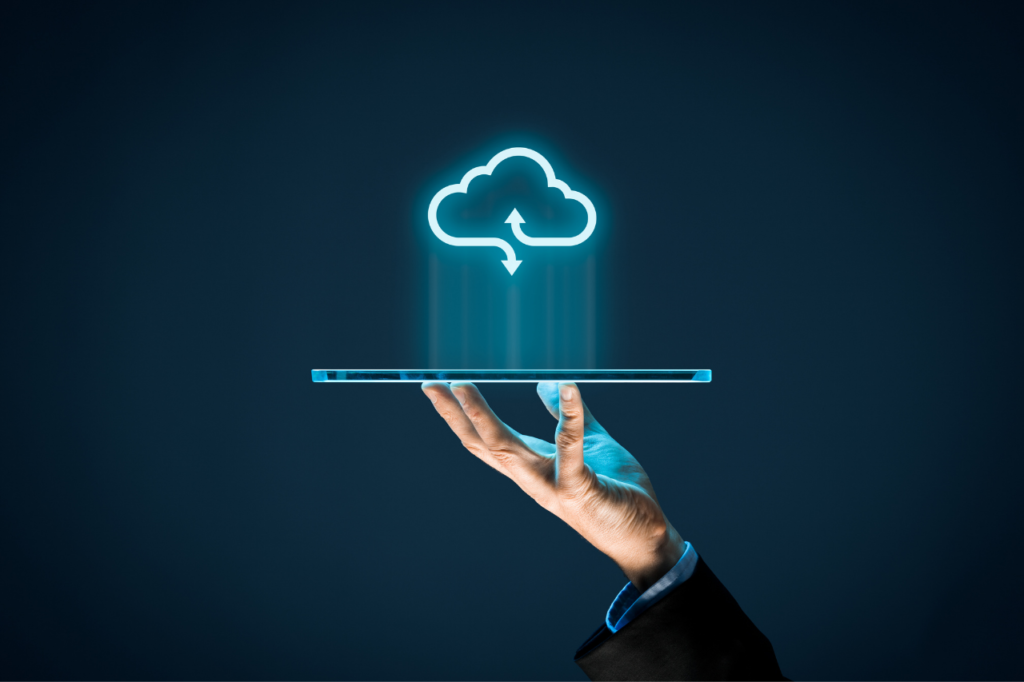In recent years, Cloud Computing has become the main technological trend in the IT world and in what is called Industry 4.0. The world of technology is often crossed by innovative trends capable of revolutionizing the certainties consolidated in the past by operators in the sector. Thus, Industry 4.0 identifies the era in which new technologies have entered businesses; to increase productivity and improve the working conditions of staff. Cloud computing is also part of this panorama, a system that is revolutionizing small and large companies by simplifying their work thanks to the Internet.
However, thanks to cloud computing, companies are now able to store large amounts of data but also build applications. Find out in the rest of this article what cloud computing is and what benefits it can bring to your business.
Table of Contents
What is Cloud Computing?
Cloud computing is part of the range of revolutionary services that are evolving in different segments of the IT industry. According to some market estimates in recent years, the cloud is playing a growing role at the expense of traditional on-premise mode. But what is Cloud Computing? Are we all sure we know it exists and how to use it? To answer these specific questions in these cases; it would be advisable to start from a definition allowing to circumscribe the field of action.
Among the many definitions, that of Microsoft (which with its Azure service and Office 365, has shown that it understands something of the cloud), appears to us very clear and exemplary. As expected above, as defined, cloud computing is nothing more than: ”The distribution of IT services, such as servers, storage resources, databases, networks, software, analytics and more, via the Internet (“the cloud”) and the companies that provide these IT services are called cloud service providers.
What does this mean in simple terms? Cloud computing is the provision of services by businesses over the Internet. Among the resources offered, you can find different products such as hardware, software, but also data storage systems. If previously the data were saved on a local disk with the risk of being damaged by use or accidents during work; you can now save this data in the cloud. Cloud computing offers an innovative system that allows everyone to access data; from any device and from any location, quickly and scalable.
Typically, service providers charge a fee for cloud computing services based on usage; like household bills for water or electricity.
What can we do with the cloud?
From this simple definition, it seems clear to us that the cloud refers to different applications and tools that can be used by the end-user; without having to perform any installation. To take advantage of the Cloud, all you need is a device (whether it is a smartphone or a simple PC) and access to the Internet.
In fact, with an Internet connection, it is possible to remotely manage the resources offered by the provider and so as a result of this process; IT services are transformed from on-site to on-demand. Any user today has the ability to get in touch with what is the most basic and still “most used” form of cloud, namely email; which perfectly describes the indications of the definition mentioned above.
The e-mail box, regardless of the supplier; is a service that can be easily used from any device connected to the Internet without the need for installations. Just think about being able to access it from your computer, tablet, or smartphone, even if you don’t have it.
From the example which has just been illustrated; anyone today can safely use cloud services to listen to music or watch movies over the internet (known as streaming). You can also use it to store pictures and other types of files; without necessarily having to save them on your smartphone or personal computer. In addition, most cloud services are completely free.
Other cloud computing options
We do not find advantages in cloud computing only as end-users, but also as entrepreneurs. Indeed, thanks to the use of cloud computing, many things can be done within a company, including:
- Create new services and applications;
- Archive data and back up and restore it;
- Hosting of websites and blogs;
- Provide software on demand;
- Analyze data (data analysis) to derive models and make estimates;
- And more.
Why Choose The Cloud Computing?

Today, the services we talked about can still be enjoyed on-site; that is, with software installed locally in the hardware.
However, the cloud computing service seems to be the better choice. In reality, it is in all respects! Why? Because it offers a series of advantages; both economical and productive. Perhaps the easiest benefit for businesses to perceive is the ability to quickly leverage IT resources at a very low cost. Specifically, with cloud computing, there is no need to make large investments in purchasing and managing hardware.
On the contrary, it is possible to provision (“collect”) the processing resources according to particular needs also because the payment is linked to the actual usage. An example: Niantic, famous for having developed the famous game Pokemon Go; took advantage of the cloud computing service, which met the project’s flexibility needs.
Also Read: How To Create Modern Website?
In fact, during the first months of launch, the game harnessed the potential of the application in question; by making it possible for hundreds of millions of people (a number which then declined considerably over time) to exploit it and thus easily cover the initial demand. With the use of the cloud, however, it was enough to gradually give up occupying “cloud space” every time the users decreased. The cloud computing service is actually based on the Pay per Use model: users pay only on the basis of actual usage; with contracts that can also be defined on a monthly basis.
So, in the end, we can say that the use of cloud computing eliminates the expenses concerning:
- The purchase of hardware and software;
- Configuration and management of the local data center (requiring server racks, 24 hour electricity for power and cooling);
- IT expertise for infrastructure management.
Cloud Computing at The Service of Businesses
Choosing the cloud is choosing speed. Instead of the physical installation of hardware and software resources in the company, with a certain optimism requires months (times which, nowadays, are hardly compatible with the speed of modern companies); thanks to the cloud, it’s the opposite. You can get huge amounts of IT resources from your provider with just a few clicks and in a very short time.
Not to mention that the largest cloud computing services operate on a global network of secure data centers; it is very important to regularly update with the latest generation of hardware; which makes them faster and more efficient. It includes a series of great advantages which are not the least; concerns the use of a cloud service offered by third parties. This could save businesses valuable time and resources dedicated to IT activities (which are usually the means and not the end of the business) .
In short, with cloud computing, customers will always be the priority. You devote yourself to them rather than devoting yourself time and effort; managing hardware devices and running servers is no small feat!
Which Cloud to Choose? Iaas, Saas, Paas, or Haas?

We cannot talk about the cloud in general terms because the range of services is so wide that it is misleading. For this reason, it is important to distinguish between the different types of cloud services.
There are four in particular, and now we’ll see what the differences are and what you need to consider when choosing one over the other. The different types make it possible to satisfy disparate needs depending on the business objective to be achieved.
The IaaSThe acronym Iaas stands for Infrastructure as a Service. IaaS solutions are typical of cloud computing. What does it mean? With an IaaS solution, you rent your IT infrastructure: servers and virtual machines (VMs), storage resources, networks, and operating systems; from a pay-as-you-go cloud service provider.
In this case, we’re using the pay-as-you-go model we were talking about earlier, pay-as-you-go.
- PaaS
PaaS stands for Platform as a Service. The scope of PaaS is different from that of IaaS. PaaS refers to cloud computing; which can provide the service for an on-demand environment (testing, distribution, and management of software applications ).
This gives developers the ability to build web or mobile applications faster and easier; without having to worry about configuring or managing the underlying infrastructure. If your company wants to create a software application, this solution is the one that should be preferred over others to best achieve the development, test, distribution, and management phases.
- SaaS
SaaS stands for Software as a Service. In recent years, particularly in the historically “software” sectors; such as security, the cloud mode called SaaS is also spreading. Technically, it can be understood as a method of distributing software applications over the Internet, always on demand.
With a SaaS solution, cloud service providers can host and manage the software application and the underlying infrastructure that supports maintenance tasks; such as software updates and security patches. The customer receives the software and can use it easily and conveniently.
- The Haas
Haas stands for Hardware as a Service. This abbreviation identifies services in which technologies are provided by an IT provider for a monthly fee; which does not make the purchase or rental necessary. It is a recommended choice for small and medium businesses; because it allows you to get a large number of resources by investing a small amount of capital. This system is perfect for those who need space to store data and hardware capable of processing it.
Public, private, or hybrid cloud: what to choose?
Regarding the distribution of cloud computing resources, it is just as important to specify the existence of a classification: it is possible to distinguish between public, private, and hybrid clouds.
Let’s take a look at the differences between these three different distribution methods.
- The public cloud
The most classic mode is the public cloud which usually consists of hardware, software, and other supporting infrastructure. These tools are all owned and operated by the cloud service provider; which allows the end-user to use them with a simple Internet connection. This type of service is typically offered by AWS, Azure, and Google.
Perfect especially for small businesses or for start-ups that have very little to take over. More complicated, however, the choice of this type of tool is adopted by a large multinational precisely, because of the complexity of its IT background; generally rich in applications developed over decades and not always compatible with cloud methods.
- Private cloud
Unlike the public cloud, the private cloud is the most adopted alternative by many organizations. This type of cloud computing actually offers a different and secure environment on which only a specific customer can operate.
Simply put, private clouds provide compute as a service to specific users in a virtual environment; using an underlying pool of physical compute resources.
However, with the private cloud model, cloud computing (as a pool of resources) is only accessible to one organization; who will therefore have better control and maximum confidentiality and security. While public clouds can adopt a certain level of security. Private clouds, referring to separate pools of resources with limited access to connections protected by an organization’s firewall; leased lines and or on-site internal hosting can guarantee protection of the various operations by protecting them from prying eyes.
In this regard, it is also important to talk about the issue of control; which has been the main obstacle to cloud adoption for several years. When information security is threatened, the impact on business processes and operations becomes negative. But the risk is not only related to the Cloud model; but also how information is used throughout the defense process.
So, as we said, the private cloud is accessible by a single organization who can then configure and manage it online according to their needs to get a customized network solution.
- The hybrid cloud
Finally, there is a third option, that of the hybrid cloud, which allows the sharing of data and applications between the two types of cloud; by giving companies more flexibility and more distribution options.
The advantage of this cloud computing model is particularly attractive to the organizations that use it. The latter, in fact, can take advantage of the flexibility and processing power of the public cloud, for basic non-sensitive processing activities; while keeping business-critical and local data and applications protected by a corporate firewall (as is. for private cloud).
For example, a company could adopt hybrid cloud hosting to host its e-commerce website in a private cloud while keeping the storefront site in a public cloud; which guarantees greater convenience (and does not require the greatest safety attention).
What risks are there with the cloud?
In fact, despite all the advantages that we have described above; even the cloud has critical aspects that are important to know.
The first, of course, concerns the availability of broadband: it is clear that if a business cannot rely on a high-performance Internet connection; moving infrastructure and services to the cloud becomes complicated. A problem that was particularly important at the beginning of the cloud ten years ago; but which is still present in the reality which dates to this day.
Another serious problem is one that affects wireless networks; which may not be secure and expose data stored in the cloud to hacking attacks. In addition, corporate CIOs very often complain about cloud service levels that do not meet expectations or what was agreed upon in contracts, so-called service level agreements; which among other things in the event of a problem, are often less clear than what the user wishes.
One big issue that can arise when using a cloud service is that of security. Businesses store sensitive customer data and this exposes them to any breach of privacy.
Other issues relate to the loss of control mentioned above, as well as the limited visibility of its infrastructure.
Finally, there is the problem of locking out cloud providers: deciding to change cloud service provider from another or to come back to the site; can be terribly complicated, also considering the continuous development of platforms and services carried out by large cloud service providers. This risks making end-users very “dependent”. In this case, data migration also becomes difficult.
A rarer question, but also important to consider, is that of the international level. Occurs when public data is stored on private clouds, but the cloud is located in a different country than the users.
Conclusion
Cloud computing is still in its infancy; although it has been used for years and its effectiveness continues to increase. Many are still turning to local storage systems. In fact, it appears that only a small percentage of businesses are making full use of the cloud. But this is the future. Shifting to the cloud can help organizations completely rethink work processes and reduce costs.
Before purchasing a cloud computing service; we recommend that you understand the needs you want to meet and find a supplier who understands them. If you want to be sure that you are making the best possible decision for your business; we recommend that you rely on industry experts.







